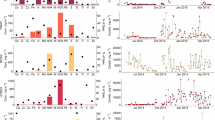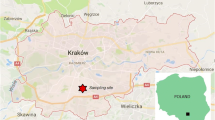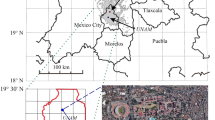Abstract
PM2.5–10 (aerodynamic diameter dae 2.5 µm ≥ x ≤ 10 µm) pollution is rapidly becoming a serious problem in many urban areas especially in the least and middle income countries where air quality guidelines as well as urban infrastructure are grossly lacking. In this regards, PM2.5–10 samples collected within a 12-month period from the industrial, low- and high- density residential areas in Lagos Nigeria were studied. The PM2.5–10 were analyzed using ion beam analyses techniques vis-á-vis particle induced X-ray emission and particle induced γ-ray emission, Hybrid Single-particle Lagrangian Integrated Trajectory (HYSPLIT) and surface meteorological data as well as Positive matrix factorization model (PMF). The results showed that the average mass loads ranged from 150 to 606 µg m−3 (industrial) 110 to 460 µg m−3 (high density residential) and 76 to 298 µg m−3 (low density residential) and revealed gross violations of local and international guidelines. In addition, the wind roses indicated that the wind flow patterns could have significant impacts on PM2.5–10 mass loads. HYSPLIT model revealed that most high episodes were caused by pollutant accumulation (induced by low wind speed) and transport of pollutants from highly polluted regions. Data on the concentrations of 22 elements (Na, Mg, Al, Si, P, S, Cl, K, Ca, Ti, V, Cr, Mn, Fe, Ni, Cu, Zn, Br, Rb, Sr, Zr, and Pb) were obtained and used for receptor modeling by PMF technique. PMF results indicated that soil dust, physical construction and industrial activities were the major emissions of PM2.5–10 and could lead to negative health implications on the inhabitants of Lagos.






Similar content being viewed by others
References
Alloway BJ, Ayres DC (1997) Chemical principles of environmental pollution, 3rd edn. Blackie Academic and Professional, London, pp 141–143
Asubiojo OI, Obioh IB, Oluyemi EA, Oluwole AF, Spyrou NM, Farooqi AS, Arshed W, Akanle OA (1993) Elemental characterization of airborne particulates at two Nigerian locations during the Harmattan season. J Radio Anal Nucl Chem 167(2):283–293
Calzolai G, Chiari M, Lucarelli F, Nava S, Portarena S (2010) Proton induced γ-ray emission yields for the analysis of light elements in aerosol samples in an external beam set-up. Nucl Instr Methods Phys Res Sect Beam Interact Mater Atoms 268:1540–1545
Campbell JL, Boyd NI, Grassi N, Bonnick P, Maxwell JA (2010) The Guelph PIXE software package IV. Nucl Inst Methods Phys Res (B) 268:3356–3363
Cohen DD, Garton D, Stelcer E, Hawas O, Wang T, Poon S, Cheol-Choi B (2004) Multi-elemental analysis and characterization of fine aerosols at several key ACE-Asia sites. J Geophys Res 109:D19S12
Cohen DD, Stelcer E, Santos FL, Prior M, Thompson C, Pabroa PCB (2009) Fingerprinting and source apportionment of fine particle pollution in Manila by IBA and PMF techniques: a 7-year study. X Ray Spect 38:18–25
doś-Anjos MJ, Lopes RT, De Jesus EFO, Assis JT, Cesareo R, Barradas CAA (2000) Quantitative analysis of metals in soil using X-ray fluorescence. Spectrochim Acta (B) 55:1189–1194
Draxler RB, Stunder G, Rolph A, Stein AF, Taylor A (2014) Hysplit4 user’s guide. National Oceanic and Atmos Administration, Silver Spring
Ezeh GC, Obioh IB, Asubiojo OI, Abiye OE (2012) PIXE characterization of PM10 and PM2.5 particulates sizes collected in Ikoyi Lagos, Nigeria. Toxicol Environ Chem 94:884–894
Ezeh GC, Obioh IB, Asubiojo OI, Chiari M, Nava S, Calzolai G, Lucarelli F, Nuviadenu CK (2015) The complementarity of PIXE and PIGE techniques: a case study of size segregated airborne Particulates collected from a Nigeria City. Appl Radiat Isotopes 103:82–92
Ezeh GC, Obioh IB, Asubiojo OI, Onwudiegwu CA, Nuviadenu CK, Ayinla SB (2018) Airborne fine (PM2.5) at industrial, high- and low-density residential sites in a Nigerian megacity. Toxicol Environ Chem 100(3):326–333
Hopke PK, Rossner A (2006) Exposure to airborne particulate matter in the ambient, indoor, and occupational environments. J Clin Occup Environ Med 4:747–771
Hopke PK, Xie Y, Paatero P (1999) Mixed multi-way analysis of airborne particle composition data. J Chemom 13:343–352
Kim E, Hopke PK, Edgerton ES (2003) Source identification of Atlanta aerosol by positive matrix factorization. J Air Waste Manag Assoc 53:731–739
Liu XG, Li J, Qu Y, Han T, Hou L, Gu J, Chen C, Yang Y, Liu X, Yang T, Zhang Y, Tian H, Hu M (2013) Formation and evolution mechanism of regional haze: a case study in the megacity Beijing, China. Atmos Chem Phys 13:4501–4514
Lott JN, Vose RS, Del-Greco SA, Ross TR, Worley S, Comeaux JL (2008) The integrated surface database: partnerships and progress; Twenty-fourth conference on interactive information processing systems for meteorology, oceanography, and hydrology. American Meteorological Society, New Orleans, USA, 131387
Maenhaut W, Francois F, Cafmeyer J (1993) The “Gent” stacked filter unit sampler for the collection of atmospheric aerosols in two size fractions: description and instructions for installation and use. Co-ordinated Research Programme: CRP E4 International Atomic Energy Agency, Vienna
Mason B (1966) Principles of geochemistry, 3rd edn. Wiley, New York
Olise FS (2003) Determination of concentration of toxic metals in the ambient air Lagos and Ile-Ife, Nigeria using total reflective X-ray fluorescence technique. An M.Sc. Dissertation title submitted to Department of Physics, Obafemi Awolowo University Ile-Ife, Nigeria
Oluyemi EA, Asubiojo OI, Oluwole AF, Toussaint CJN (1994) Elemental concentrations and source identification of air particulate matter at a Nigerian site. Nucl Anal Methods Atmos Pollut Studies 179(2):187–194
Paatero P (2007) User’s guide for positive matrix factorization programs PMF2 and PMF3, part 1–2: tutorial, 19–21. University of Helsinki, Finland
Rajyalakshmi G, Sri HK (2018) Characterization of PM10 and impact on human health during annual festival of lights (Diwali). J Health Pollut 8(20):181206
Salvador P, Artıñano B, Alonso D, Querol X, Alastuey A (2004) Identification and characterization of sources of PM10 in Madrid (Spain) by statistical methods. Atmos Environ 38:435–447
Stohl A (1998) Computation, accuracy and applications of trajectories-a review and bibliography. Atmos Environ 32:947–966
UNEP/WHO (1994) GEMS/AIR methodology reviews 1, suspended particulate matter in ambient air. WHO/EOS/94.3, UNEP/GEMS/94.A.4, UNEP, Nairobi, United States Environmental Protection Agency (USEPA), National Air Quality and Emissions Trends Report
WHO (2006) Air quality guidelines for particulate matter, ozone, nitrogen dioxide and sulfur dioxide, Global update 2005. World Health Organization, Geneva
WHO (2016) Ambient (Outdoor) air quality and health. http://www.who.int/mediacentre/factsheets/fs313/en/
Yttri KE, Aas W, Bjerke A, Cape JN, Cavalli F, Ceburnis D, Dye C, Emblico L, Facchini MC, Forster C, Hanssen JE, Hansson HC, Jennings SG, Maenhaut W, Putaud JP, Tørseth K (2007) Elemental and organic carbon in PM10: a one year measurement campaign within the European Monitoring and Evaluation Programme (EMEP). Atmos Chem Phys 7:5711–5725
Zhang D, Iwasaka Y (1999) Nitrate and sulphate in individual Asian dust-storm particles in Beijing, China in spring of 1995 and 1996. Atmos Environ 33:3213–3223
Zhang T, Claeys M, Cachier H, Dong S, Wang W, Maenhaut W, Liu X (2008) Identification and estimation of the biomass burning contribution to Beijing aerosol using levoglucosan as a molecular marker. Atmos Environ 42:7013–7021
Acknowledgements
Special thanks to the management of Lagos State Environmental Protection Agency (LASEPA) for the mobility support during field works. Authors appreciate the International Atomic Energy Agency (I.A.E.A.) Vienna Austria, for NIR 12022 Postgraduate Fellowship granted to Ezeh G.C. We also acknowledge the assistance of Dr. Chiari Massimo of Department of Physics and Astronomy, University of Firenze and I.N.F.N., Via Sansone 1, 50019 Sesto Fiorentino (FI), Italy for facilitating NIR 12022 programme at Firenze.
Author information
Authors and Affiliations
Corresponding author
Ethics declarations
Conflict of interest
No potential conflict of interest was reported by the authors
Rights and permissions
About this article
Cite this article
Ezeh, G.C., Obioh, I.B., Asubiojo, O. et al. A study of PM2.5–10 pollution at three functional receptor sites in a sub-Saharan African megacity. Aerosol Sci Eng 3, 65–74 (2019). https://doi.org/10.1007/s41810-019-00044-3
Received:
Revised:
Accepted:
Published:
Issue Date:
DOI: https://doi.org/10.1007/s41810-019-00044-3




